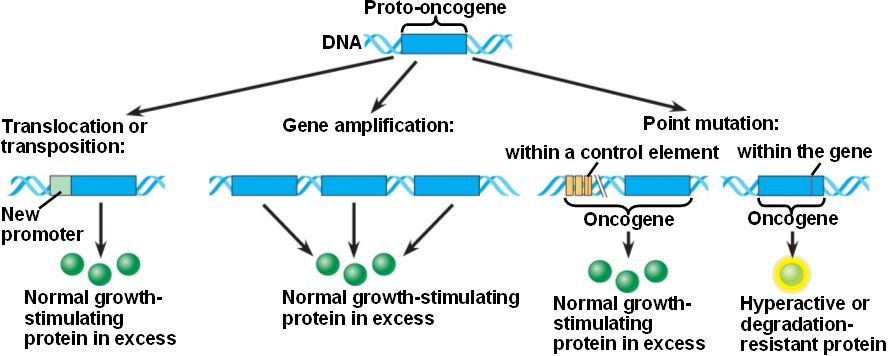Chapter 14 Summary
Mutations
Mutation are both fatal and necessary aspects of existence, depending on the way they occur. Mutations are necessary for evolution, adaption, as well as variation in human genomes. Mutations are changes in the DNA, which affect everything thereafter. There are several types of mutations. A point-base mutation only a single base pair within the DNA through base substitution. The first kind of mutation is a silent mutation in which a nucleotide is changed but it has no effect on the the DNA's synthesis. A missense mutation causes an amino acid to change in the polypeptide. Nonsense mutation substitute a nucleotide which then form a stop codon, and protein production stops prematurely. Another type of mutation is the frame-shift mutation in which nucleotides (NOT in multiples of 3) are added or deleted, and everything thereafter is read differently and in different combinations. Mutations can lead to diseases and abnormalities. Mutations in promoter sequences and such locations can increase or decrease rate of transcription, affect the DNA's ability to properly structure RNA, or even alter transcription all together. Mutations is somatic cells aren't transferred to gametes, only germ-line mutations are.
DNA Repair
Our body has a DNA repair system to fix the mutations that occur spontaneously. There are three types of repair mechanisms. In direct repair, a repair enzyme recognizes an imperfection and directly converts it to the correct form. In base excision and nucleotide excision repair, an abnormal base or nucleotide is recognized, and a portion of the strand containing the abnormality is removed. The complementary DNA strand is then used as a template to synthesize a normal DNA strand. In Methyl-directed mismatch repair, similar to excision repair except that the DNA defect is a base pair mismatch in the DNA, not an abnormal nucleotide. The mismatch is recognized, and a strand of DNA in this region is removed. The complementary strand is used to synthesize a normal strand of DNA.
Cancer
Cancer is a disease of multicellular organisms that is an effect of uncontrolled cell division. Outside factors, also known as carcinogens, such as uv rays, radiation, and smoke can cause mutations in DNA, and increase the chances of cancer. On your DNA, a normal and healthy coding sequence is referred to as a proto-oncogene. When proto-oncogenes go under mutations and are not repaired, they form oncogenes, which are cancerous. Usually when there is not more space left to divide, cells stop dividing. However in cancer, these cells buildup and start forming masses called Tumors. Tumors are benign at first (not cancerous and and anchored in a fixed position. Tumors then become malignant (cancerous and spreading). Malignant tumors are what cause death. Tumor Repressor Genes on the other hand code for proteins that prevent cancer and aid in repairing damaged DNA. Mutations to the tumor repressor genes could also cause oncogenes to form, which then lead to uncontrolled cell division. Cancer can also be caused by gene amplification, chromosomal translocation, and retroviral insertion. In gene amplification, multiple copies a proto-oncogene are made, which leads to a over production of a certain protein, which can then lead to cancer. Another type is chromosomal translocation is which parts of different chromosomes break off, fuse together or exchange places, forming Chimeric Genes, which can then lead to cancer because of new abnormal coding sequences and altered functions. The thirst type is retrovial insertion in which a oncogene of a virus is inserted into the healthy human DNA, causing it to now become cancerous. To safe gaurd against cancer, our cell cycle has check points at the G1, G2, and M phase to prevent the replication of diseased or damaged DNA. Proteins at these checkpoints calidate the DNA for the next step. If the DNA is damaged, other proteins are signaled and the the damaged cells proceeds towards apoptosis. However, if the proteins at these checkpoints are inhibited, then the damaged DNA is replication, leading to complications.
Useful Links
1.

Dr. Weber mentioned how cancerous DNA is "messed up". These various karyotypes are of colon cancer patients. This image of cancer DNA particularly interested me because I've lost my grandfather to colon cancer, and it has always been interesting to learn the different aspects of colon cancer. You can see that most of the chromosomes groups are defected and there are many translocated chromosomes as well.
2.

This image shows how the proto-oncogene can be altered in different ways. It pretty much sums up the main types of mutations and changes than can occur to proto-oncogenes.
3. Differential Expression of Cell-cycle Regulatory Proteins Defines Distinct Classes of Follicular Lymphoma - In this experiment, the scientists were looking for ways to reduce Follicular Lymphoma. They hypothesized that in their sample, an alteration to the Rb signaling pathway would lead to a more aggressive disease. So combat that, they altered the expression of key cell-cycle regulatory proteins and increased expression of p53 or p16 (INK4a). This lead to a overall reduction in the cell life. Over-expression of those proteins also reduced conventional pathological markers of tumor aggressiveness including high histologic grade.
Comments (1)
Derek Weber said
at 12:16 am on Feb 16, 2011
Missing discussion of oncogenes and temor suppressor genes.
You don't have permission to comment on this page.